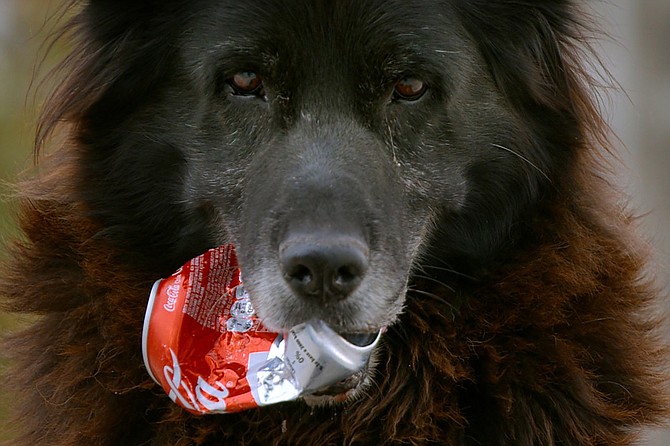 Facebook
Facebook
 X
X
 Instagram
Instagram
 TikTok
TikTok
 Youtube
Youtube

There are two real dogs behind the canine stars of Los Reyes; their names are Football and Chola, and they really do spend their days (and nights) hanging around the titular skate park — the oldest one in Santiago, Chile. But directors Bettina Perut and Iván Osnovikoff aren’t making a documentary, however grounded their world. The dogs here are characters; not so much stray dogs as sentries, inhuman observers of human folly. (For one thing, they look great, with none of the stray’s matted mange; for another, they are never shown scavenging and begging for food.) And since their real-life counterparts aren’t named until the end of the film, I came to know them as Big and Red.
Big is the obvious alpha, a solid, dark Labrador sort of dog with a deep fondness for balls, especially tennis balls. He frequently makes a game out of nosing a ball close to the skate bowl’s rim, then snatching it before it drops out of reach. Sometimes, it gets away from him; when it does, it’s Red who goes down after it. Red’s more of a Shepherd in appearance, though he’s less inclined to chase passing mopeds and donkeys, and more inclined to let loose his hoarse, whiny bark — at least, when his mouth isn’t closed around a rock, or a plastic bottle, or a crumpled can of Coke. The way a retriever might.
Big and Red live a dog’s life at Los Reyes: laying and lolling about, panting and playing and occasionally getting a little attention from the park’s human visitors. And while the dogs are the stars, it’s those humans who drive the narrative, largely through off-camera conversations, their subtitled chatter superimposed over images of the animals. Funnily enough, one of those visitors refers to the world of daily work and steady paychecks as “a dog’s life,” when nothing could be further from the truth. That stuff is thoroughly human, however wretched it seems to the people in question.
Those people are mostly young men — or rather, boys dreaming they are young men. They make plans for their brilliant futures in the cannabis industry even as their mother’s boyfriends punish them for sleeping in, as their grandmothers call them nasty names, as their mothers try to get them into rehab. They go into business with the world, only to have the world give them the business: mean cops, crooked customers, etc. They posture and threaten, boast and whine, and while away their youth atop their boards. It’s a masterful portrait of societal breakdown and masculine drift, approached in sly and sidelong fashion: as background to the peaceful days of Big and Red, happy mammals who never give thought to the approaching and encircling flies.


There are two real dogs behind the canine stars of Los Reyes; their names are Football and Chola, and they really do spend their days (and nights) hanging around the titular skate park — the oldest one in Santiago, Chile. But directors Bettina Perut and Iván Osnovikoff aren’t making a documentary, however grounded their world. The dogs here are characters; not so much stray dogs as sentries, inhuman observers of human folly. (For one thing, they look great, with none of the stray’s matted mange; for another, they are never shown scavenging and begging for food.) And since their real-life counterparts aren’t named until the end of the film, I came to know them as Big and Red.
Big is the obvious alpha, a solid, dark Labrador sort of dog with a deep fondness for balls, especially tennis balls. He frequently makes a game out of nosing a ball close to the skate bowl’s rim, then snatching it before it drops out of reach. Sometimes, it gets away from him; when it does, it’s Red who goes down after it. Red’s more of a Shepherd in appearance, though he’s less inclined to chase passing mopeds and donkeys, and more inclined to let loose his hoarse, whiny bark — at least, when his mouth isn’t closed around a rock, or a plastic bottle, or a crumpled can of Coke. The way a retriever might.
Big and Red live a dog’s life at Los Reyes: laying and lolling about, panting and playing and occasionally getting a little attention from the park’s human visitors. And while the dogs are the stars, it’s those humans who drive the narrative, largely through off-camera conversations, their subtitled chatter superimposed over images of the animals. Funnily enough, one of those visitors refers to the world of daily work and steady paychecks as “a dog’s life,” when nothing could be further from the truth. That stuff is thoroughly human, however wretched it seems to the people in question.
Those people are mostly young men — or rather, boys dreaming they are young men. They make plans for their brilliant futures in the cannabis industry even as their mother’s boyfriends punish them for sleeping in, as their grandmothers call them nasty names, as their mothers try to get them into rehab. They go into business with the world, only to have the world give them the business: mean cops, crooked customers, etc. They posture and threaten, boast and whine, and while away their youth atop their boards. It’s a masterful portrait of societal breakdown and masculine drift, approached in sly and sidelong fashion: as background to the peaceful days of Big and Red, happy mammals who never give thought to the approaching and encircling flies.
Comments